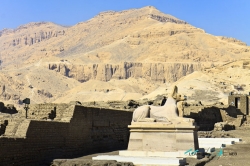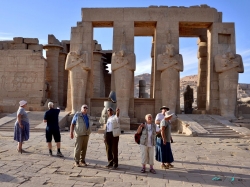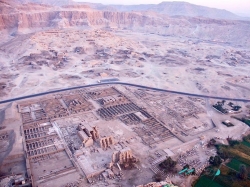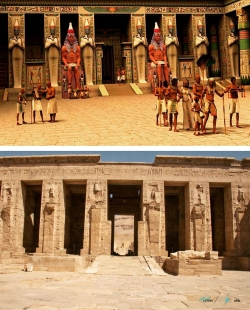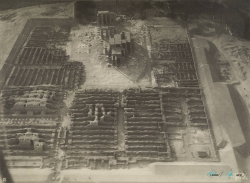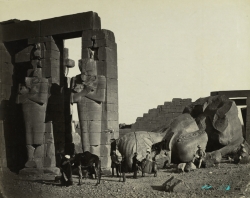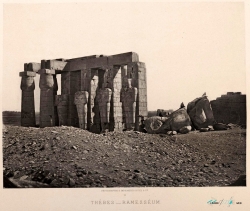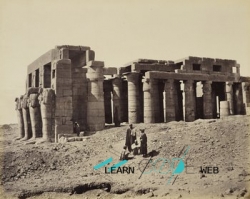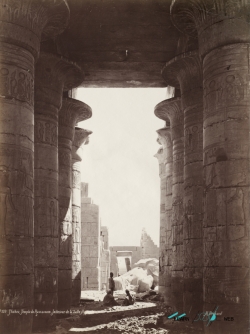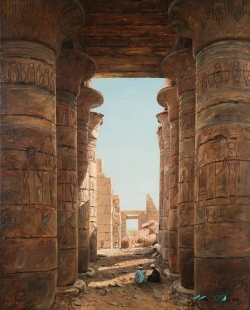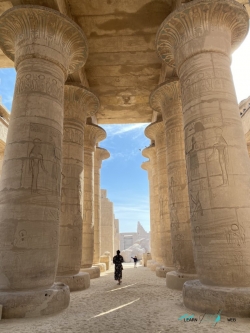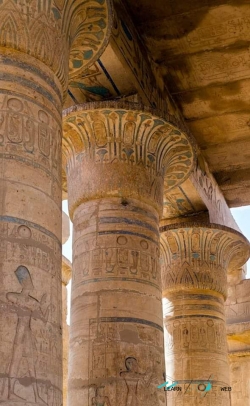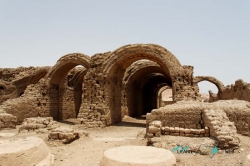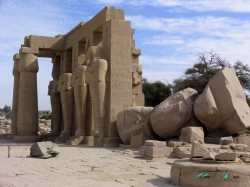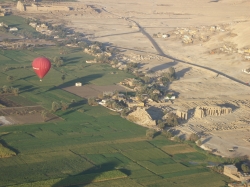The Ramesseum is the millions-year-old temple of Ramses II, also serving as a university, located in the Theban necropolis, opposite Luxor, Egypt.
North of the Colossi of Memnon, located between the temple of Amenhotep II to the north and that of Thoutmôsis IV to the south, on the left bank of Thebes "the city of a hundred gates", is erected the Ramesseum of which it does not remain today only ruins. It was visited around 300 BC by Hecataeus of Abdera, a visit which is reported to us in the 1st century BC by the Greek historian Diodorus of Sicily; in his collections, he describes this Tomb of Osymandyas as the most majestic in all of Egypt.
So named by Champollion, the “castle of millions of years” was the place where the renewal of the divine essence of pharaoh was celebrated. Large estate, surrounded by a high wall, in its center was the temple, surrounded by buildings for the celebrations of feasts, administrative offices, priests' houses, workshop, warehouses and a palace where Ramses resided during his came to the site.
Important economic, cultural and religious center, the castle of millions of years was a point of intellectual convergence and theological reflection.
The publication in 1928 by Kurt Heinrich Sethe of the dramatic papyrus of the Ramesseum discovered in 1896 in the tomb of “the magician” made it possible to attest to the existence of a theater in ancient Egypt.
Since 1991, Christian Leblanc, with the Association for the Safeguarding of the Ramesseum, has been leading the excavation and restoration of the site.
A statue of Ramses II, in pink granite, lies broken on the ground in this temple dedicated entirely to the pharaoh Ramses II; it must have measured about eighteen meters. This statue weighing approximately one thousand tons, one of the largest statues in the country, can be seen from outside the temple.
North of the Colossi of Memnon, located between the temple of Amenhotep II to the north and that of Thoutmôsis IV to the south, on the left bank of Thebes "the city of a hundred gates", is erected the Ramesseum of which it does not remain today only ruins. It was visited around 300 BC by Hecataeus of Abdera, a visit which is reported to us in the 1st century BC by the Greek historian Diodorus of Sicily; in his collections, he describes this Tomb of Osymandyas as the most majestic in all of Egypt.
So named by Champollion, the “castle of millions of years” was the place where the renewal of the divine essence of pharaoh was celebrated. Large estate, surrounded by a high wall, in its center was the temple, surrounded by buildings for the celebrations of feasts, administrative offices, priests' houses, workshop, warehouses and a palace where Ramses resided during his came to the site.
Important economic, cultural and religious center, the castle of millions of years was a point of intellectual convergence and theological reflection.
The publication in 1928 by Kurt Heinrich Sethe of the dramatic papyrus of the Ramesseum discovered in 1896 in the tomb of “the magician” made it possible to attest to the existence of a theater in ancient Egypt.
Since 1991, Christian Leblanc, with the Association for the Safeguarding of the Ramesseum, has been leading the excavation and restoration of the site.
A statue of Ramses II, in pink granite, lies broken on the ground in this temple dedicated entirely to the pharaoh Ramses II; it must have measured about eighteen meters. This statue weighing approximately one thousand tons, one of the largest statues in the country, can be seen from outside the temple.



